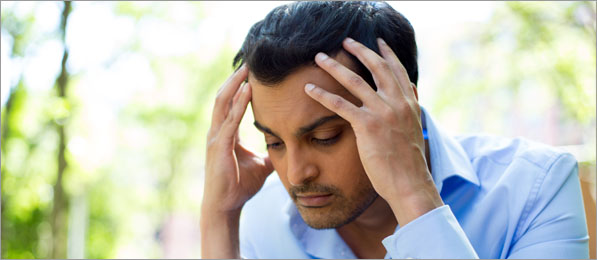Migraine

Changing world and modern lifestyle have led to a hectic routine for human beings. Today everybody is in a situation where there is a struggle to maintain a balance between work and life. Concentrating on one affects the other, many a time leading to serious health implications like chronic headaches and migraine. Frequently carrying work home, unable to leave office on time, skipping meals, less intake of water and less sleep have become a part of normal routine of many people, especially women who have to shoulder various responsibilities.
Headache is a term, which literally describes pain felt anywhere in the head. Headache is caused by a disturbance of the pain sensitive structures in the head. Within the cranial cavity, there are a few pain sensitive structures. Pain can be evoked from the venous sinuses, the arteries and dura at the base of the brain. Displacement and distortion of these structures, particularly if rapid, cause headache. Among the 12 cranial nerves, V, IX, X cranial nerves contain pain fibres and direct compression of these nerves produces pain.
Migraine is a recurrent throbbing headache that characteristically affects one side of the head. Migraine is possibly caused by constriction and then dilation of the arteries of the brain. An initial phase of vasoconstriction causes symptoms of less blood supply to the brain and this is followed by vasodilatation. This change affects both intra and extra cranial arteries. The dilation of extra cranial vessels causes pain by stretching the pain nerve ending in the arterial wall.
Migraines attacks may be precipitated by variety of factors such as:
- Menstruation
- Flashing light
- Disturbance in sleep
- Stress and anxiety
- Allergies to certain types of substances like strong perfumes, skipping meals, are common precipitants.
Symptoms
Headache usually begins in one spot and subsequently involves the whole of one side of the head. The pain is usually severe, and throbbing is associated with vomiting, photo-phobia, pallor, sweating and prostration, which may necessitate the patient taking to bed in a darkened room.
According to ayurveda, precipitating factors cause vitiation of vata and kapha. Vitiated vata covers the kapha in the arterial wall. This vata avrita kapha affects the dhamanis of brain and decreases the circulation. This leads to headache, migraine and sensation of vomiting. Avrita kapha clears after vomiting and patient feels relief from headache.
Treatment
Ayurveda does not propagate short-term pain relief for Migraine patients. Rather, it believes in cleaning the body from within and eradicating the disease from its roots. Ayurvedic treatment of Migraine therefore is centred on the pacification of Pitta Dosha, and restoration of digestive function in the body. Nervine tonics are also recommended to enhance the ojas, relax the mind and give strength to the nervous system. Patients are given herbal medicines as well as customised diet and lifestyle plans in accordance with their body constitution and the root cause of disease. When the body’s digestion is enhanced, ama production gets controlled, leading to cleansing of manovahi strotas. As a result, patients can get long-term relief from the most chronic of pains
Panchakarma
Ayurvedic treatment therapies, known as Panchakarma, are also effective in treating Migraine pains. Nasya (administration of herbal oils into the nostrils) and Shirodhara (head massage) are especially highly recommended to such patients. Both procedures are aimed at removing the cause of the headache and the pain.
Prevention
- Avoid bright light
- Get a good night sleep; try not to sleep late
- Don’t skip meal. Make a habit to take small meals frequently.
- Keep tab on what you eat
If there is a migraine attack, just lie down in a dark room; put an ice pack wrapped in a towel on the head.
As soon as you feel headache, take analgesics/painkillers or other medicines to reduce stress, pain and go to sleep.

